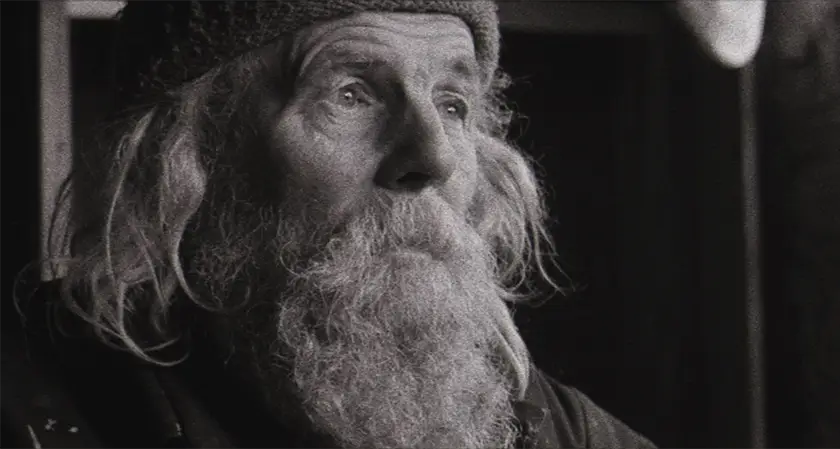Bogancloch is an ambitious work of storytelling, and the payoff is rewarding. For those with an eye for experimental slow cinema, this film is exceptional.
Director: Ben Rivers
Genre: Documentary
Run Time: 86′
U.K. Release: May 30, 2025
U.S. Release: TBA
Where to Watch: In U.K. and Irish cinemas
Movies don’t have to feature top notch CGI or an outlandish plot to be considered ambitious. Sometimes, the boldest films are the quiet ones; those which conduct a deep character study or unravel the very core of humanity by perpetually training the camera on people as they navigate their lives. In this way, Bogancloch is an incredibly ambitious project.
It’s been over a decade since Ben Rivers documented the quaint life of Jake Williams in Two Years at Sea, following Williams after he transitioned from nautical life to reclusive mountain dwelling. He was so enamored with sharing Williams’s story with the world, he had to return to capture more, which resulted in Bogancloch, another chapter in the life of an inventive and cheerful man. Bogancloch is beautifully shot and captivating as experimental filmmaking, even though some elements of the non-narrative structure detract from the film’s goals.
Shot on 16mm film and edited to present a gritty, lo-fi portrait of Williams, Bogancloch cherishes long takes and slow moments. Rivers captures the landscape of Bogancloch, the highland forest of Scotland where Williams lives, in every season. Warm days give way to barren trees and snow-covered mountaintops. All the while, Williams dedicates himself to projects like sorting through his cassette tape collection, building a model of the solar system out of an umbrella, and fashioning an outdoor hot tub.

Documentaries require investigation into the lives and settings of their subjects. It’s natural for documentarians to narrate personal explanations or include interview footage from their findings. But there is no exposition or dialogue in Bogancloch; the sound of voices is rarely present in the 86 minute documentary. Rivers notes in the synopsis that he was aiming at “something less recognisable, a different existence of reality observed in discrete moments,” and that he wrote a loose treatment of the scenes rather than a script. He trusts—and even requires—the camera to do the storytelling rather than using his own words. His choices for filming certain moments in the life of Williams are still intentional, of course, but he’s not telling the viewer what to think. He simply presents it as he captured it, emphasizing the experience of the footage rather than his interpretation of every moment.
This is a strong and good element that makes Bogancloch stand out among a host of exposition-heavy documentaries, but it also results in slower, less important moments. There are some scenes in which it is unclear what Williams is doing, if he’s doing anything at all, and they disrupt an otherwise recognizable intentionality in his daily life. This, paired with a strange occurrence of shots which function as interludes between sequences, results in the viewer being somewhat removed from the ordinary life that Rivers is capturing.
There is, however, one transcendent moment in Bogancloch that perfectly captures the life of Williams and the goal of the documentary. At the heart of the film is a folk song in which the lyrics present an argument between life and death about what the world would be like if each one of them ruled. This song and the moments following it present Williams with a deeper sense of purpose and connection, to both nature and the (few) people around him. The journey ends with a fascinating long take that does justice to the slow cinema technique seen in films like Bresson’s Pickpocket and Tarkovsky’s Mirror.
Bogancloch is a bold, contemplative work of storytelling, but the payoff is rewarding. For those with an eye for slow cinema, experimental editing, and an intimate depiction of a quiet life, this film is exceptional. In another ten years, maybe Rivers will gift the world with a third film on Williams and his ordinary, beautiful life.
Bogancloch: Movie Plot & Recap
Synopsis:
Jake Williams lives in the Scottish highland forest of Bagoncloch. This documentary uses experimental filmmaking to focus on his daily life through small moments. It also captures the landscape through all seasons and weather. This documentary about Williams is a sequel to Two Years at Sea (2011).
Pros:
- Unique and ambitious documentary
- Beautiful cinematography and experimental style
Cons:
- Some non-narrative moments detract from the focus on the main subject
Bogancloch will be released in cinemas in the U.K. & Ireland on May 30, 2025.

